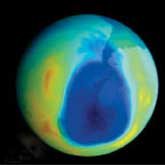The Good, the Bad and the Ozone
 Ozone is a big buzz word these days. We mostly hear about the ozone layer, and the importance of protecting it. But if you want to understand what ozone's all about, you need to understand that it can be good, and it can be bad. The stratosphere is the layer of the atmosphere from 10 to 30 miles above sea level. When there's ozone in this layer, it protects us from solar radiation. How? Simple chemistry. Regular oxygen molecules, known to science-types as O2, are made up of two oxygen atoms stuck together. Solar energy shoots in from space and splits that molecule into two atoms. When one of those stray atoms attaches to a full-fledged O2 molecule, you've got, well, O3, otherwise known as ozone. All that action blocks solar radiation, and keeps it from reaching us.
Ozone is a big buzz word these days. We mostly hear about the ozone layer, and the importance of protecting it. But if you want to understand what ozone's all about, you need to understand that it can be good, and it can be bad. The stratosphere is the layer of the atmosphere from 10 to 30 miles above sea level. When there's ozone in this layer, it protects us from solar radiation. How? Simple chemistry. Regular oxygen molecules, known to science-types as O2, are made up of two oxygen atoms stuck together. Solar energy shoots in from space and splits that molecule into two atoms. When one of those stray atoms attaches to a full-fledged O2 molecule, you've got, well, O3, otherwise known as ozone. All that action blocks solar radiation, and keeps it from reaching us.
How can solar radiation be harmful to life on Earth? Part of that radiation is ultra-violet, or UV radiation. It's an intense energy from the Sun that can cause a whole lot of damage. Skin cancer is the most dramatic result of a too much UV radiation, but there's a lot more too. Photosynthesis in plants is also affected, and that causes problems for the whole food chain. See where this is headed? We need to protect our ozone shield, and we can do so by decreasing the pollution that our industrial society puts out in large amounts every day.
Let's come down a little closer to Earth. The troposphere is everything below the stratosphere, from sea level to about 10 miles above. It's where everything lives. Things that happen to the troposphere happen to us; there's nothing indirect about it. Put a little ozone in the troposphere and you've got some big problems. Remember those dramatic chemical reactions that happened up in the stratosphere? Living things are made of atoms and molecules too, so when we expose them to ozone, we've got some serious chemical reactions on our hands. In humans, it means lung damage. Small children and people with asthma are especially at risk. Cars, trucks and SUVs are the biggest contributor to this ozone buildup. Engine exhaust creates nitrogen dioxide, so the more you drive, the more your vehicle creates. High gas prices aren't the only reason to leave the car in the garage.
Fact Credit
NASA Headquarters


